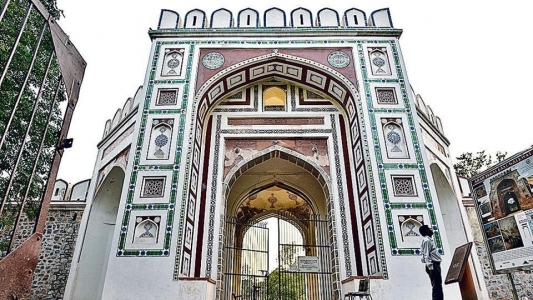Mughal-era Arab ki Sarai gateway restored to its old glory in Delhi 2018-05-28
According to Indian National Trust for Art and Cultural Heritage (INTACH) listing of ancient structures in Delhi, Arab Sarai was built in 1560 by Hamida Banu Begum, who was chief consort of Mughal emperor Humayan, to accommodate 300 Arabs she had brought back from Mecca.
The lofty eastern gateway of a walled enclosure built in the 17th century — which was originally a market built during Jahangir’s reign along side Arab ki Sarai, Nizamuddin East — has been restored to its old glory.
The restorer, Aga Khan Trust for Culture (AKTC), began restoration work in January 2017.
The 13 metre-high, five-arched gateway, topped with battlements is two-bay deep. It also has chambers and a domed roof flanked by niches on both sides. The spandrels are ornamented with detailed tile work and medallions bearing Quranic inscriptions.
“This gateway, which leads to a bazaar attached to the sarai, is one of the rare structures in Delhi with inscriptions. Restoration of missing incised plasterwork has been completed. The concrete cement terrace flooring has also been carefully removed and replaced with traditional lime concrete terracing with appropriate slopes and water outlets,” said Rajpal Singh, chief engineer at AKTC.
The doorway, a blend of red sandstone and Delhi quartzite, had degenerated. In the past, it was repaired with cement mortar that led to water stagnation.
Multiple cracks allowed water penetration leading to dampness and salt deposits. Quranic inscriptions were buried under the layer of cement plaster, tiles were missing and portions of the roof of the gateway had collapsed.
“Sadly, not all of the artwork could be restored as evidence had been lost. As a result, central ceiling medallion had to be left blank. Some of the newspaper articles dating back to 1960s suggest that its walls were adorned with paintings of human figures but that could not be restored,” said Ujwala Menon, AKTC’s conservation architect.
According to Indian National Trust for Art and Cultural Heritage (INTACH) listing of ancient structures in the national capital, Arab Sarai was built in 1560 by Hamida Banu Begum, who was chief consort of Mughal emperor Humayan, to accommodate 300 Arabs she had brought back from Mecca.
In Sair-ul-Manazil, a Persian book written in the 1820s, author Sangin Beg referred this inn as “property of Arabs and other general populace.”
Author Ranjan Kumar Singh in his book, ‘The Islamic Monuments of Delhi’, said Mihr Banu, chief eunuch at Jahangir’s court, added the market to the inn.
The market (constructed around the 1620s) complex has arched cells reportedly used as shops and living quarters by travellers and traders.
“The spandrels of these rectangular framing are decorated with marble medallions and carvings in Persian, which suggest that the bazaar gateway was built during Mughal emperor Jahangir’s period,” said Menon.
The major portions of the sarai is with the Delhi government from where it runs an Industrial Training Institute, which was set up in 1948 by the ministry of rehabilitation as a vocational training center for people who were displaced during the country’s partition. With the successful completion of conservation of the doorway, the trust will start restoration of a baoli located on the inn campus, said Ratish Nanda, CEO of AKTC.
The restoration was carried out with monetary help from US Ambassador’s Fund For Cultural Preservation.
- 4928 reads
 Ismaili.NET - Heritage F.I.E.L.D.
Ismaili.NET - Heritage F.I.E.L.D.